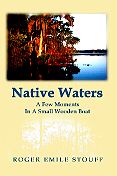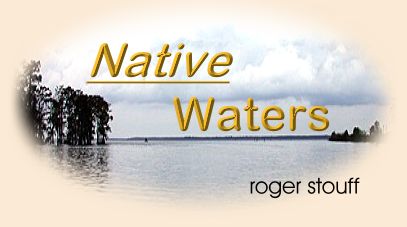|
(EDITOR'S NOTE: This is the fifth in a
series of columns on Stouff's recent trip
to Browning, Montana to fish for trout on
the Blackfeet Indian Reservation for an
upcoming episode of "Fly Fishing America"
to be aired next spring.)
Chief Mountain stands at the eastern edge
of the Rockies where the range suddenly
bolts to the northwest near Canada at
almost a forty-five degree angle. A
solitary and juggernaut feature, Chief
Mountain is like a sentinel guarding the
way across the divide. Though I was only
in Montana for a few days, its presence
each morning when I looked up into the
Backbone of the World from Browning was
a comfort.
Cutbank Creek had turned up a buncha trout
for me, frantic, beautiful rainbows. In the
first day alone I had managed to learn to
cast in relation to the wind, walk across
streams without losing my footing (most of
the time) and caught many trout, as well as
something they called a Rocky Mountain
Bonefish, or whitefish. Looked like a trout
to me, what do I know? I'm from the swamps.
It had been decided that day we would head
up to Otatso, a creek north of Browning
near Glacier National Park. To get there
would be a two-hour ride and then a trek
down a road that Joe Kipp described as "brutal."
I was to learn later that he was in fact being
polite.
Joe's son Max joined us that day and I rode
with him for the trek. The rest of the crew
followed in two other vehicles. Once we left
the main road, the short trail to Otatso was
brutal, all right. More than once I hit my
head on the top of the truck cab, and was
jarred and jumbled, but I never wondered if
we'd make it through. Max knew his business -
he had guided his first fishing client when
he was six - and though I arrived tossed and
shaken, we got there safely and none the worse
for wear. We did, however, see grizzly tracks
on the way in, but Joe said it was a small
one and not to worry about it.
On a ridge overlooking the creek, Otatso
chanted and sang below us. We geared up, a
process that took up to half an hour or more,
and I observed that trout fishing was pretty
"worky" when you get right down to it. I mean,
back home we throw our tackle in a boat, put
the boat in the water, drive to where we want
to fish, fish until we've had enough, then
come home. But we ambled down the ridge slowly,
finding ourselves at last on the banks of the
creek. I learned I had to sidestep to get down
the ridge, as wading shoes with felt soles are
great for maintaining a foothold on slippery
rocks, but slide like a wet penguin on vegetation.
At that point I realized I had left my hat in
the truck, and Bill, the videographer, was kind
enough to go back and get it for me, surely
recognizing that a Montanan would be able to
do so in about ten minutes, whereas a Louisianan
might take an hour or never return at all. I
was very grateful. The canyon that hid Otatso
Creek was deep, its sides steep and forbidding.
We would have to fish our way down a few miles,
Joe said, to a point where we could climb out
and reach the trail back to our vehicles again.
Regardless, this was perhaps the finest water
I had seen since arriving in Montana, and that's
saying a lot. Otatso was gorgeous, secluded and
pristine. In my entire time in Montana I saw not
a single scrap of litter. I mentioned this to
Mick who said he wasn't sure if that was because
Montanans are so much more noble, or if it all
just blows into Wyoming.
Once again, our guide showed he knew his
business and his waters better than anyone
and he put me onto many wonderful trout on
Otatso, all cutthroats. Joe would go ahead of
us, survey likely pools and wait for us to
catch up. While individual anglers can fish
the Blackfeet Nation waters with a proper
permit, they can only fish the headwaters
of many areas with a guide because of the
bull trout. Listed as a threatened species,
the Blackfeet authorize headwaters fishing
only with a guide to help assure these fish
remain viable. It is illegal to even
intentionally target these fish, and if one
is caught while fishing other species it must
be released at once.
We caught plenty of cutthroats, though! Joe
knew the best pools and the best ways to fish
them, and by the end of the day I had caught
plenty. There was one particular pool that we
fished subsurface and coaxed a couple especially
nice trout from. It was pretty cool because both
Joe and I stood upstream of where water was raging
over this shallow dropoff, hurtling itself below,
and the trout were in the pools behind big boulders
or at the seams between the quieter water and the
moving flow. I think my best trout on Otatso was
about 14 inches, but I'm still a rank amateur,
don't forget.
The hike back to the vehicles was excruciating,
and I learned an odd thing: The smokers in the
group just went along like nobody's business,
while I, at the time nine weeks into my cessation,
was wheezing like a dilapidated Hoover. At the end
of the trail was the same ridge we had gone down
to fish in the beginning, and now we had to go up.
That ridge nearly licked me, I admit, and had to
take two breaks on the ascent to catch my breath.
If a grizzly had come by right then I wouldn't
have had to remind myself not to run - I didn't
have the breath to try anyway. In fact, I got to
studying on that ridge, all full of wildflowers,
looking over chortling Otatso creek, and thought,
"Put me up a marker right here, and I'll just stay
for eternity." But then I remembered I hadn't had
any fry bread in Montana yet, so I got up and made
it the rest of the way.
After passing the brutal road back, we took
the highway again. There was still plenty of
time to fish since full dark doesn't come
until about 10:30 in Montana that time of
year, so we were off to Goose Lake. This
was quite a piece away, but finally we
turned off the highway again and began
climbing into the foothills of the Backbone
of the World. There were three vehicles,
often separated by a quarter mile, and the
folks in the lead vehicle that evening got
to see a grizzly.
It was just a few dozen yards away from them,
and at first they thought it was a cow. There's
cattle everywhere you look in Montana, but then
this creature took off in a way only a grizzly
can run, they said, and there was no mistaking
the awesome size, gait and profile of it.
Some of the crew wanted to turn back then,
since the bear was heading right toward
Goose Lake, but Joe shrugged and said, "It's
my land, too," and so we pushed on.
All the time we were gearing up - inflating
float tubes and pontoon boats, putting on
waders, assembling rods - we could hear cattle
raising hell all around. They mooed and fussed
and groaned, obviously irate and uneasy about
the proximity of the grizzly. I never saw it,
though, and while I wish I had in a way, the
notion of a closer encounter than a look-see
does not appeal to me.
Learning to use a float tube wasn't hard,
really. Just sit in it like an easy chair
and paddle with the flippers on your feet.
Since I have considerable expertise with
easy chairs, I adapted quickly. Goose Lake
is cold, of course, but there is heavy
vegetation in it. Joe instructed us to
fish along the edge of these by drifting
or paddling and either casting or trolling
subsurface flies - woolly buggers and the
like - along the weedline. This resulted
in my two best trout of the entire trip,
both in the 20-inch range, just before
sundown. These were cutthroat trout,
characterized by the slashes of orange-red
below their jaws, gorgeous creatures, soft
and strong. Again, the expertise of Morning
Star Troutfitters had allowed a south Louisiana
newbie to fish trout and to exceed all his
wildest expectations.

I don't know how high in altitude we were
at Goose Lake but the near-sunset was
gorgeous, the air clear and thin. I was
grateful that there were no more ridges
for me to climb to get back to the vehicles.
With two magnificent trout capping two days
of great fishing, I was pretty smug.
We finished up right at dark, made the
long trek back to the Kipp ranch, tired
and satisfied. The following day would be
wrap-up filming, final interviews and a
few more moments on the water. ~ Roger
 It's out! And available now! You can be one of the
first to own a copy of Roger's book. Native Waters: A
Few Moments in a Small Wooden Boat
It's out! And available now! You can be one of the
first to own a copy of Roger's book. Native Waters: A
Few Moments in a Small Wooden Boat
Order it now from
www.iuniverse.com, Amazon.com,
or Barnes & Noble.com.
Roger will also be giving away three autographed copies to
readers. Stay tuned, for an announcement on the Bulletin
Board on that soon.
|



 It's out! And available now! You can be one of the
first to own a copy of Roger's book. Native Waters: A
Few Moments in a Small Wooden Boat
It's out! And available now! You can be one of the
first to own a copy of Roger's book. Native Waters: A
Few Moments in a Small Wooden Boat